Sold For Parts: Selma Selman’s Activist Practice
“I don’t want art that points to a thing. I want art that is the thing.”
–Tania Bruguera
In 2018, Selma Selman, an artist of Romani origin who grew up in Bosnia and Herzegovina (henceforth referred to as Bosnia), set out to buy her freedom from her family. Recording her project on film, she negotiated a fair price to make up for the dowry her parents would forgo in not marrying her off. She proceeded to sell her hair, her clothes, and her artworks before officially making the exchange of $11,166 for her independence. Selman’s aim was, in her own words, “to free myself from the tradition of marriage as well as to free my parents from the obligatory traditional measures and provide a model for the future generation in our mutual project of collective self-emancipation.” (Selman Portfolio, accessed 7 March 2021, https://239598f9-af2e-4777-8e57-3e9ed255e5b0.filesusr.com/ugd/587616_9782dcd63de6474e966e54b8893e5619.pdf) With I Will Buy My Freedom When and her project Marš u Školu (2017-present), Selman not only thematizes the Romani material conditions she grew up in, but also directly intervenes in them. Her actions subvert and perform the circulation of goods and capital in these material conditions, thus encouraging a new generation of Bosnian Romani women to realize their political power.
Selman grew up in Bihać, a town in the northwestern part of Bosnia near the Croatian border. After receiving her BFA in painting from Banja Luka University in 2014 and working with the acclaimed artist Mladen Miljanović, she studied sociology and anthropology at Central European University in Budapest before completing an MFA at Syracuse University.(Selma Selman website, accessed 3 August, 2022, https://www.romarchive.eu/en/collection/p/selma-selman/) I Will Buy My Freedom When was her MFA thesis project. Selman has had several solo exhibitions and participated in group shows, notably the Roma Pavilion at the Venice Biennale in 2019, where I first encountered her work. In August 2021, the National Gallery in Sarajevo launched a retrospective of her work, and she participated in Documenta 15, and the 2022 Manifesta 14 in Prishtina, Kosovo. She also features on the front cover of the October 2022 issue of Harper’s Bazaar Serbia with the tagline “Nova Era Optimizma” (“New Era of Optimism”). In other words, Selman is becoming an influential cultural figure beyond the art world proper.
Journalists often remark that Selman plays with her identity in much the same way she plays with artistic traditions and media. (Jelena Prtoric, “Selma Selman is the Bosnian artist breaking down cars, washing machines, and the patriarchy,” The Calvert Journal, November 4, 2020, accessed January 1, 2021, https://www.calvertjournal.com/features/show/12282/selma-selman-bosnian-roma-artist-performance-activism-painting) She is clearly indebted to both performance and feminist video art; in the performances You Have No Idea (2016) and Don’t Look Into The Eyes Of A Gypsy (2014), she evokes Marina Abramović’s repetitive chanting in the latter’s 1973 work Art Must Be Beautiful, Artist Must Be Beautiful, but she looks us squarely in the eyes, challenging us to confront the abjection we are complicit in perpetuating. Self-Portrait (2017), in which Selman destroys a washing machine with libidinal fervor, has something of the uncanny jocundity of Pipilotti Rist’s Ever is Over All (1997). However, her use of camera angles and cuts gives Selman’s Self-Portrait, and works like it, a narrative aspect that differentiates them from the durational video works of her forebears, like a simulcast of an opera production: a performance that is at once a documented process and a re-cut assemblage of footage.
Indeed, process, transvaluation and circulations of materials and signs are at the heart of Selman’s practice. Her 2020 video work Mercedes Matrix presents a detailed study of the process by which she sources her materials, an illustration of the transformation of raw materials into commodities through labor. In it, she and her family break down a Mercedes in front of an audience, repackaging a common Roma occupation of scrap-yard labor as a generative process of analysis of a whole into its disparate parts leading into the transvaluation of those parts into artworks. These artworks are, in turn, sold to finance her activist project. Though Selman herself does not care for the idea of Roma art as a category, which is to say the idea that work produced by Romani artists has a particular recognizable style, her Roma identity is nevertheless a key part of her work, and she is often grouped with other Romani artists. Romani artists have only been recognized as a group since the second half of the twentieth century, with the establishment of the first World Romani Congress in 1971. Before that, Roma productions were thought of as “collective facts of nature, which only become a concrete representation when they are in some way presented by an art collector or folklorist.” (Timea Junghaus, “Roma Art: Theory and Practice,” Acta Ethnographica Hungarica 59, 2014, 28.) Even then, it took the establishment of the Roma Pavilion at the Venice Biennale in 2007, for a heterogenous group of Romani artists to be exhibited publicly without the words “primitive,” “naïve” or “outsider” being attached to their work. The outsider is a political category as well as an aesthetic form. It should accordingly be read not as a criticism of the artists, but of the educational and political systems that do not welcome them. Nevertheless, it remains a fraught concept; if we take it at face value, we find that it cannot be made to accommodate Selman, who is classically trained. But it is her drawings and plastic works, and her use of found objects such as car parts as canvases for portraits in her long-running series Works on Metal, that have the potential to be read as stereotypical Outsider art. It is this potential that makes the series a crucial aesthetic and conceptual part of her overall practice.
Labor Triptychs: Film, Care and the Sexual Economy
I Will Buy My Freedom When is compelling for its visual format alone. The 8:58 video composes three moving images stacked like a vertical triptych, but arranged horizontally across the screen’s surface. This causes viewers to have to tip their laptop screens sideways to experience the action right side up—the video oscillates between three, two and one moving images on screen. This format “bridges the visual vocabulary of both art and commerce while standing apart from both” (Selma Selman, “Art as Tool” (Master’s thesis), 2018, 12.), underlining the manufactured aspects of both cultural tradition and documentation. In one scene triad, Selman’s mother sweeps the driveway of their house, her brother makes a trip to the hardware store and dreams about purchasing a car, and her father proudly shows off a row of ammunition from the war he found in his junkyard: “you could put this in a museum, it would be amazing!” Another split screen finds Selman’s mother serving snacks and her brother and father working in the junkyard.
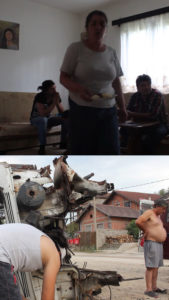
Selman’s mother serves snacks while her brother and father work in the junkyard. Selma Selman, I Will Buy My Freedom When, video, 10′, loop video still, 2018, ©Selma Selman
Domestic, working-class and ethnic minority labor is here shown to be behind the ritualistic display of cultural heritage. An extended and mesmerizing closeup of a blanket Selman’s mother is washing in the bathtub is followed by a split-screen of Selman’s brother lovingly challenging his father to a wrestling match after the latter has accused him of being a layabout. Though the family’s irreverent and, at times, melodramatic banter belies the cinematographic eye of someone who grew up during the golden age of opulent reality TV, the detailed focus on financial and domestic minutiae recalls the socialist realism of Aki Kaurismaki or Marta Meszaros. This focus comes out in the first part of the video, as well as in the second, an advertisement for a sale of her belongings and the products of her labor, her artworks, to raise the necessary capital for the transaction.

Closeup of Selman’s mother washing a blanket. Selma Selman, I Will Buy My Freedom When, video, 10′, loop video still, 2018, ©Hella Wiedmer-Newman
Labor is a red thread in Selman’s work, especially the way labor and capital characterize intimate relationships. In I Will Buy My Freedom When she continues a discussion opened by Serbian artist Tanja Ostojić’s 2000-2005 Looking for a Husband with a EU Passport, which takes the form of a personal ad posted on a website, but includes elements of performance, as when she meets up with a German artist who expresses interest in her proposition, and indeed marries her, and also when they get divorced in another public gesture four years later. (Zdenka Badovinac, “Future from the Balkans”, October 159, Winter 2017, 111.) Ostojić’s piece reflects the general ghettoization and paternalization of the Former Yugoslavia, caught up in structures of UN funding, but mostly excluded from the EU (Slovenia joined the EU in 2004, Croatia in 2013, while Bosnia, which applied in 2013, is still waiting to be considered as a candidate), contributing to what art historian Uroš Čvoro terms “transitional aesthetics.”(Uroš Čvoro, Transitional Aesthetics: Contemporary Art at the Edge of Europe, London: Bloomsbury, 2018) We can see hints of this transition, for Romani Bosnians in particular, in the vision of Romani domestication exemplified by her mother’s housework (and her brother’s taste for conspicuous consumption). This vision challenges the often romanticizing, but ultimately racializing, stereotype of Romani people as primitive, itinerant or criminal, while at the same time highlighting the transition to neoliberalism. Selman’s work draws attention to the lack of social structures accessible to the Roma within a post-socialist society, while at the same time addressing the need for a revaluation of women’s labor. By juxtaposing her mother’s unpaid domestic labor with her male relatives’ waged labor, she stages this revaluation of housework as a political perspective that would carry with it what Silvia Federici refers to as “a revolutionizing” of “all our family and social relations.”(Silvia Federici, Wages Against Housework (Bristol: Power of Women Collective and Falling Wall Press, 1975), 1.) This attempt at revolutionizing relations is what underlies Selman’s project as a whole.
The most notable thing about I Will Buy My Freedom When is Selman’s matter-of-fact, yet critical treatment of the subject of arranged marriage. Child and arranged marriages are still a source of income for some Romani families, and Selman’s sister and mother were both married off at young ages in return for a dowry. Her nuanced gaze is encapsulated in the irony and warmth in her family’s responses to her question, posed again and again: “How much do I have to give you, so you won’t marry me off?” This question contains within it a degree of resistance that is a far cry from the overt smash-the-patriarchy mode of some of her other works. Instead of offering a caricature of Roma culture, Selman’s family (and Selman herself, at times giggling audibly behind the camera) enact a script of negotiating their daughter’s dowry that mimics negotiations in any market. “7-8000 Euro, what it cost to clothe and feed you. That’s what Gypsy girls usually go for,” her father says, with a ribald grin. “Enough for a car,” replies her brother, Muhammed, while lying on the couch and, below, enjoying a barbeque in the sun. “You can just give me 50 cents,” her mother chortles while cleaning the windows and, in the bottom screen slice, hanging the laundry to dry. What emerges from these shots is a vision not only of contemporary Bosnian Roma custom and labor, but also one of Roma joy, humor and silliness.
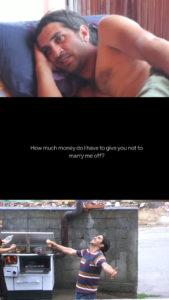
Selman’s brother lies on couch while negotiating price with Selman, then enjoys a barbeque. Selma Selman, I Will Buy My Freedom When, video, 10′, loop
video still, 2018, ©Selma Selman
The tradition of marrying girls off as child brides originated in the 15th century, when it was used as a way of protecting Romani girls and women from being attacked by their Ottoman overlords. (ibid., 10.) Of course, child and arranged marriages have long been practiced all over the world in the name of power and control, but Selman’s point is that in the contemporary Bosnian context, it has been wielded against the Roma by the public at large as a further way of marginalizing them. The slippage between the visuals of everyday life and the dialogue embedded in them lays bare a history of oppression. Selman creates an aesthetic of economic realism and ambivalence, which simultaneously critiques the patriarchal structures of the Roma family system and turns our prejudices back onto us by exposing the transactional nature of heterosexual relationships at large.(The idea of sexual economics was advanced by social psychologists Roy Baumeister and Kathleen Vohs in their 2004 article “Sexual Economics: Sex as Female Resource for Social Exchange in Heterosexual Interactions” and critically reexamined by Kristen Ghodsee in her 2020 book Why Women Have Better Sex Under Socialism: And Other Arguments for Economic Independence.)
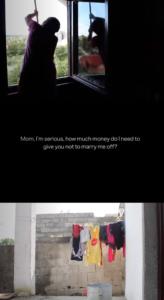
Selman’s mother cleans windows while negotiating price with Selman, then hangs laundry out to dry. Selma Selman, I Will Buy My Freedom When, video, 10′, loop video still, 2018, ©Hella Wiedmer-Newman
Activism via Art: Protesting the Maintenance of Crisis & Constructing Citizenship
What connects I Will Buy My Freedom When and the artist’s activist project, Marš u Školu, or Get the Heck to School, is their focus on the limits of Roma citizenship. As Ioanna Szeman writes, in the vein of a decolonial and collectivist pan-European Roma politics “all Roma experience a citizenship gap to different degrees, depending on class, gender, occupation, age, geographical location and so on, despite the visibility of Roma post-1989 as performers or as victims of poverty and discrimination…”.(Ioana Szeman, Staging Citizenship. Roma, Performance and Belonging in EU Romania (New York: Berghahn, 2018,) 5.) Quoting sociologist Nira Yuval-Davis, Szeman defines ‘actual citizenship’ as “…the ability to take advantage of the citizenship rights that have been gained through legal citizenship but which, if ‘understood as private ‘liberties’ or ‘choices,’ are meaningless, especially for the poorest and most disenfranchised, without enabling conditions through which they can be realized’”.(Nira Yuval-Davis, “Women, Citizenship and Difference,” Feminist Review 57, quoted in Ioana Szeman, Staging Citizenship. Roma, Performance and Belonging in EU Romania, 3.) In Bosnia specifically, there is a direct limitation placed on Romani Bosnian passport holders, written into the country’s constitution. During the Bosnian war of the 90s, Roma fought on all three ethnic sides, but did not particularly ally themselves with any of them, leading to their being designated as “others” (Jewish people also fall under this category) in the Dayton Agreement of 1995, which in turn provided a framework for Bosnian’s new constitution. This has led to the current population of 30,000 to 50,000 people being especially isolated and discriminated against, as only members of the three distinct ethnic groups are protected under the constitution’s Articles IV and V.(Articles IV and V state that “The Presidency of Bosnia and Herzegovina shall consist of three Members: one Bosniac and one Croat, each directly elected from the territory of the Federation, and one Serb directly elected from the territory of the Republika Srpska.” Jennifer Paton, “The Roma Minority & Free Election Rights in Bosnia and Herzegovina: The Problem of Constitutional Reform,” Aberdeen Student Law Review 23 (2013), 26.) This designation as other excludes Romani people in Bosnia from standing for election to the House of Peoples and the Presidency.(ibid., 31.) It also leads to difficulty in accessing housing, healthcare and education, among other services. This is a direct infringement of Romani participation in political life, without which there can be no proper citizenship.
Selman’s website features two separate tabs, one for art and one for activism. While intimately entwined, these two facets of her professional identity have separate aesthetics, the first scrappy and irreverent, the second more slick and corporate-looking. In one selfie she and seven pre-teen girls beam at the screen.

Selfie of Selman and Seven Scholarship Holders Get The Heck to School, 2017, ©Selma Selman
Another is an image of Studio Selma Selman in Bihać, from where she organizes her projects.
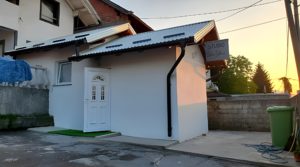
Selma Selman Studio Selma Selman Studio, Ružica, Bihać, Bosnia and Herzegovina, 2017, ©Selma Selman
While her activism was sponsored by the BHeart Foundation (a prominent non-profit organization) for one year, it has since been self-financed. There is much to criticize about humanitarian aid and the often-self-serving attachment of notable people to social justice projects. But this work comes out of Selman’s political concerns and does not fall into the trap of the hollow socially engaged art projects, which have become increasingly common. Verónica Tello unpacks the problems of such projects which seek to “construct new institutions and infrastructures most often with the resources and support of the art world” by extending their “reach towards other social systems and structures and their deficiency.” (Verónica Tello, “What is Contemporary about Institutional Critique,” Third Text Vol. 34, 2020, 637.) In this vein, the project Studio Selma Selman consisting of a library / studio / community center set up in Bihać, self-consciously tries to “avoid past failures of attempting to transplant majority-friendly strategies to minority communities…structured to intervene precisely at community, city and cross-national scales”. (Selma Selman Portfolio. https://239598f9-af2e-4777-8e57-3e9ed255e5b0.filesusr.com/ugd/587616_9782dcd63de6474e966e54b8893e5619.pdf.) As Tello writes: “The community is put to work in a kind of ‘non-politics of inclusion’ where art, in lockstep with business, gives the impression of empowerment but actually inhibits the capacity to question systemic structures that maintain inequity. The solidarity required to organize against exploitation or marginalization is difficult to locate as the discourse around recovery and crisis becomes one about exploiting market resources in order to address the crisis but never to protest the maintenance—that is, the making and perpetuating—of crisis.” (Verónica Tello, “What is Contemporary about Institutional Critique,” 647.) Tello’s analysis is convincing but misses the mark about what exactly the problem is with what she describes as ‘instituent practice’. It is not necessarily that the work uses the vocabulary, strategies, and backing of the commercial art world, but, quite simply, that it fails to provide its ostensible beneficiaries with the concrete tools they need to “protest the maintenance of crisis”.
Marš u školu (Get the Heck to School) is Selman’s organization that seeks to increase the rate of primary school attendance for Roma children, girls in particular. It has already managed to increase attendance from 15 to 95% and achieved a lasting intervention into the educational infrastructure through the provision of academic scholarships and hot lunches. It thereby constitutes a step towards the closing of the citizenship gap by ensuring these girls can channel energy into their political development because their basic needs are taken care of. The project also connects to the art market. Echoing I Will Buy My Freedom When, Selman sells her physical art works—much of which consist of oil portraits painted onto pieces of scrap metal that through their readymade materiality can be, and have been, easily classified as “Roma art” in an institutional setting (See example here: https://www.gypsydada.com.)—in order to sponsor each of her activist projects.
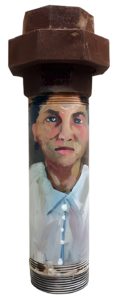
Object from Works on Metal series, portrait, acrylic paint on scrap metal, 11x11x42cm 2016, ©Selma Selman
By using the proceeds from her artworks to fund her socially engaged projects, she is releasing herself from the obligation to create a participatory art project masquerading as humanitarian aid. The coals that power her activist engine thus become the reification of her performative Romani identity; activism via, as opposed to qua, art. The documentary material that results from her activist actions, meanwhile, itself circulates, adding to, and complicating, the narrative of Roma art.
A Call for New Socialism or the Ultimate Neoliberal Use of Artistic Labor?
It is possible to read Marš u Školu and I Will Buy My Freedom When as both a critique of corporate neoliberal feminism and, paradoxically, as its unabashed celebration. The first project highlights the disparities in citizenship for Roma women, but instead of a new piece of educational policy, it offers a private foundation with limited governmental funding. The second thematizes the commodification of Roma women in contemporary Bosnia and makes visible the intrinsic value of care labor. But instead of demanding better access to waged labor, social housing, childcare, etc., which would increase female economic independence, it showcases one woman, who is educated and relatively privileged, raising the money to free herself from a form of servitude. What may at first appear to be Marxist feminism is, in fact, indicative of the transition to neoliberalism evident in the designer gyms and restaurants gradually cropping up in Bosnia’s larger cities. But Selman never claimed to be a socialist and why should she be? Perhaps she is illustrating, like Ostojić, the lengths to which artists, especially female artists, must go not only to perform their own empowerment, but also to address questions of social justice. This double expectation arises, in a post-Lean In world, from the continuing construction of woman as carer. Or is she eliding all of these as a way of playing on viewer expectations? As Arnisa Caterina Zeqo recently observed: “her practice plays with the various expectations of what an artistic practice by a minoritarian subject should be in an age of neoliberal corporate discourse.” (Arnisa Caterina Zeqo, “Potential Value of Scrap Metal: Selma Selman,” Mousse 28.09.2022) But how far does subtle subversion really get you when you are dealing with the fates of real subjects?
Another possibility is that Selman is trying to change the system from within its structures, favoring strategic everyday resistance over dramatic systemic change. Meaningful policymaking is hard at the best of times and under the most favorable conditions, let alone in a country with mass corruption, unemployment, and an educational system more based on separating, than uniting, students. Perhaps all that can currently happen is for an NGO to give a generation of Roma girls the tools to gain a political voice in order to make lasting change in the future and an intimate and nuanced exploration of arranged marriage. It is the circulation of goods, capital and meaning from a Bosnian Roma perspective that Selman represents in her work. The business of breaking down norms and selling them for parts.





